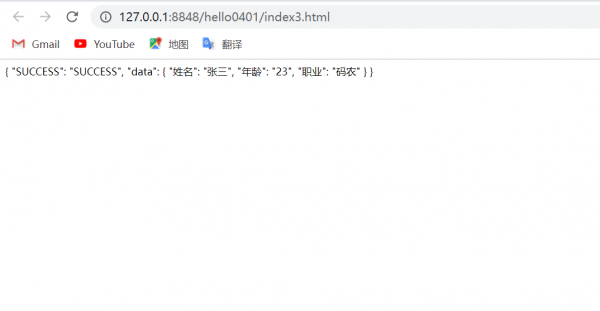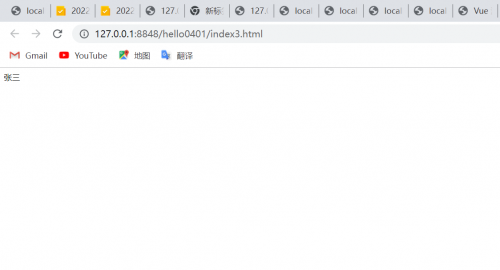“Vue的前后端通信(axios)”的版本间的差异
来自CloudWiki
(→前后端通信) |
|||
| 第21行: | 第21行: | ||
==前后端通信== | ==前后端通信== | ||
| − | === | + | ===基本GET方法=== |
使用 response.data 读取 JSON 数据: | 使用 response.data 读取 JSON 数据: | ||
| 第108行: | 第108行: | ||
[[文件:vue2022041605.png|500px]] | [[文件:vue2022041605.png|500px]] | ||
| + | ===GET方法传参数=== | ||
| + | GET方法传参数有两种写法: | ||
| + | |||
| + | <nowiki> | ||
| + | // 直接在 URL 上添加参数 ID=12345 | ||
| + | axios.get('/user?ID=12345') | ||
| + | .then(function (response) { | ||
| + | console.log(response); | ||
| + | }) | ||
| + | .catch(function (error) { | ||
| + | console.log(error); | ||
| + | }); | ||
| + | |||
| + | // 也可以通过 params 设置参数: | ||
| + | axios.get('/user', { | ||
| + | params: { | ||
| + | ID: 12345 | ||
| + | } | ||
| + | }) | ||
| + | .then(function (response) { | ||
| + | console.log(response); | ||
| + | }) | ||
| + | .catch(function (error) { | ||
| + | console.log(error); | ||
| + | });</nowiki> | ||
| + | |||
| + | 具体代码: | ||
| + | |||
| + | <nowiki> | ||
| + | <!DOCTYPE html> | ||
| + | <html> | ||
| + | <head> | ||
| + | <meta charset="utf-8"> | ||
| + | <title>Vue 测试实例 - 菜鸟教程(runoob.com)</title> | ||
| + | <script src="https://cdn.staticfile.org/vue/2.4.2/vue.min.js"></script> | ||
| + | <script src="https://cdn.staticfile.org/axios/0.18.0/axios.min.js"></script> | ||
| + | </head> | ||
| + | <body> | ||
| + | <div id="app"> | ||
| + | {{ info }} | ||
| + | </div> | ||
| + | <script type = "text/javascript"> | ||
| + | new Vue({ | ||
| + | el: '#app', | ||
| + | data () { | ||
| + | return { | ||
| + | info: null | ||
| + | } | ||
| + | }, | ||
| + | mounted () { | ||
| + | axios | ||
| + | .get('http://127.0.0.1:5000/hello',{ | ||
| + | params: { | ||
| + | ID: 12345 | ||
| + | } | ||
| + | }) | ||
| + | .then(response => ( | ||
| + | this.info = response.data)) | ||
| + | .catch(function (error) { // 请求失败处理 | ||
| + | console.log(error); | ||
| + | }); | ||
| + | |||
| + | } | ||
| + | |||
| + | }) | ||
| + | </script> | ||
| + | </body> | ||
| + | </html> | ||
| + | |||
| + | |||
| + | </nowiki> | ||
| + | |||
| + | ====对应Flask代码==== | ||
| + | <nowiki> | ||
| + | import json | ||
| + | from flask import Flask,request | ||
| + | app = Flask(__name__)#创建一个该类的实例,第一个参数是应用模块或者包的名称 | ||
| + | from flask_cors import * | ||
| + | |||
| + | @app.route('/hello')#告诉Flask 什么样的URL能触发函数 | ||
| + | @cross_origin() | ||
| + | def hello_world(): | ||
| + | #return 'Hello World!' | ||
| + | s=['张三','年龄','姓名'] | ||
| + | t={} | ||
| + | t['ID'] = request.args.get('ID') | ||
| + | t['姓名']='张三' | ||
| + | t['年龄']='23' | ||
| + | t['职业']='码农' | ||
| + | data={} | ||
| + | data['SUCCESS']='SUCCESS' | ||
| + | data['data']=t | ||
| + | return json.dumps(data,ensure_ascii=False) | ||
| + | |||
| + | |||
| + | if __name__ == '__main__':#程序入口 | ||
| + | app.run()#让应用运行在本地服务器上。 | ||
| + | #app.run( host='0.0.0.0') #允许任意网址访问本站</nowiki> | ||
==参考文档== | ==参考文档== | ||
菜鸟教程:https://www.runoob.com/vue2/vuejs-ajax-axios.html | 菜鸟教程:https://www.runoob.com/vue2/vuejs-ajax-axios.html | ||
2022年4月16日 (六) 04:32的版本
axios简介
Vue.js 2.0 版本推荐使用 axios 来完成 ajax 请求。
Axios 是一个基于 Promise 的 HTTP 库,可以用在浏览器和 node.js 中。
Github开源地址: https://github.com/axios/axios
环境准备
安装axios
使用 cdn:
<script src="https://unpkg.com/axios/dist/axios.min.js"></script>
或
<script src="https://cdn.staticfile.org/axios/0.18.0/axios.min.js"></script>
后端准备
可参考Vue+Flask前后端传参,搭建一个Flask框架。
前后端通信
基本GET方法
使用 response.data 读取 JSON 数据:
<!DOCTYPE html>
<html>
<head>
<meta charset="utf-8">
<title>Vue 测试实例 - 菜鸟教程(runoob.com)</title>
<script src="https://cdn.staticfile.org/vue/2.4.2/vue.min.js"></script>
<script src="https://cdn.staticfile.org/axios/0.18.0/axios.min.js"></script>
</head>
<body>
<div id="app">
{{ info }}
</div>
<script type = "text/javascript">
new Vue({
el: '#app',
data () {
return {
info: null
}
},
mounted () {
axios
.get('http://127.0.0.1:5000/hello')
.then(response => (this.info = response.data))
.catch(function (error) { // 请求失败处理
console.log(error);
});
}
})
</script>
</body>
</html>
读取具体单个数据:
<!DOCTYPE html>
<html>
<head>
<meta charset="utf-8">
<title>Vue 测试实例 - 菜鸟教程(runoob.com)</title>
<script src="https://cdn.staticfile.org/vue/2.4.2/vue.min.js"></script>
<script src="https://cdn.staticfile.org/axios/0.18.0/axios.min.js"></script>
</head>
<body>
<div id="app">
{{ info }}
</div>
<script type = "text/javascript">
new Vue({
el: '#app',
data () {
return {
info: null
}
},
mounted () {
axios
.get('http://127.0.0.1:5000/hello')
.then(response => (
this.info = response.data.data['姓名']))
.catch(function (error) { // 请求失败处理
console.log(error);
});
}
})
</script>
</body>
</html>
GET方法传参数
GET方法传参数有两种写法:
// 直接在 URL 上添加参数 ID=12345
axios.get('/user?ID=12345')
.then(function (response) {
console.log(response);
})
.catch(function (error) {
console.log(error);
});
// 也可以通过 params 设置参数:
axios.get('/user', {
params: {
ID: 12345
}
})
.then(function (response) {
console.log(response);
})
.catch(function (error) {
console.log(error);
});
具体代码:
<!DOCTYPE html>
<html>
<head>
<meta charset="utf-8">
<title>Vue 测试实例 - 菜鸟教程(runoob.com)</title>
<script src="https://cdn.staticfile.org/vue/2.4.2/vue.min.js"></script>
<script src="https://cdn.staticfile.org/axios/0.18.0/axios.min.js"></script>
</head>
<body>
<div id="app">
{{ info }}
</div>
<script type = "text/javascript">
new Vue({
el: '#app',
data () {
return {
info: null
}
},
mounted () {
axios
.get('http://127.0.0.1:5000/hello',{
params: {
ID: 12345
}
})
.then(response => (
this.info = response.data))
.catch(function (error) { // 请求失败处理
console.log(error);
});
}
})
</script>
</body>
</html>
对应Flask代码
import json
from flask import Flask,request
app = Flask(__name__)#创建一个该类的实例,第一个参数是应用模块或者包的名称
from flask_cors import *
@app.route('/hello')#告诉Flask 什么样的URL能触发函数
@cross_origin()
def hello_world():
#return 'Hello World!'
s=['张三','年龄','姓名']
t={}
t['ID'] = request.args.get('ID')
t['姓名']='张三'
t['年龄']='23'
t['职业']='码农'
data={}
data['SUCCESS']='SUCCESS'
data['data']=t
return json.dumps(data,ensure_ascii=False)
if __name__ == '__main__':#程序入口
app.run()#让应用运行在本地服务器上。
#app.run( host='0.0.0.0') #允许任意网址访问本站

